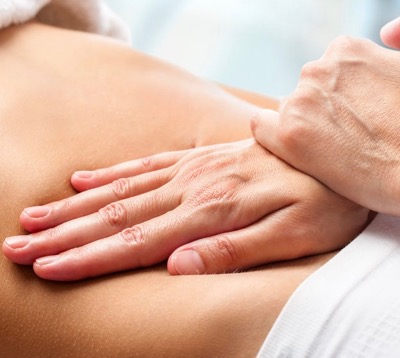- Home
- Western Massage
- Visceral Manipulation
As an affiliate for Bookshop, Amazon, and other programs, I may earn a small commission for products purchased through links. This doesn't affect the price you pay. Privacy policy and disclosures.
Search this site:
What is Visceral Manipulation Massage Therapy?
Visceral manipulation encourages the organs (viscera) and surrounding connective tissues to move normally, creating mobility and tone in the organs.
What is Visceral Manipulation Theory?
French osteopath and physiotherapist Jean Pierre Barral developed this fascial mobilization technique, which is specific to the organs, based on his observations and experience working with patients. Here's a little of the theory.
Your body can maintain harmony and health only when free and open movement exists between your organs and their connective tissues. Organs that glide and move freely function better, as does the system to which the organ belongs, giving the whole body better structural integrity. Any restrictions adversely affect health.
Ideally, the relationship between your organs and your muscles, membranes, fascia, and bones remains the same even as your body moves. But an organ can become stuck due to poor tone, adhesions (stuck-together tissue), or displacement caused by surgery, scars, trauma, or stress.
A stuck organ no longer moves in harmony with its surroundings, which can cause tension patterns throughout the body's deep fascial network. Your body must then compensate for these patterns, creating fixed, abnormal points of tension that the body must move around. This chronic irritation leads to functional and structural problems.
All internal organs are connected to the spine by support membranes. When support membranes become tense, they pull the spine out of alignment. Muscles compensate for this misalignment, potentially leading to pain, inflammation, disease, or other dysfunction throughout the body.
Interview with Jean-Pierre Barral

In addition to visceral manipulation, Barral has developed two other modalities. Neural Manipulation looks at mechanical relationships between the cranium/spine hard frame and the dura and neural elements. Manual Articular Approach treats the joints.
Books by Barral include:
- Understanding the Messages of Your Body: How to Interpret Physical and Emotional Signals to Achieve Optimal Health
- Visceral Manipulation I and II
- Manual Therapy for the Peripheral Nerves
What is a Visceral Manipulation Session Like?
The goal of a practitioner is to help your body return to normal function by encouraging normal mobility, tone, and movement of your internal organs and their connective tissues. First, therapists listen with their hands to determine the location of restrictions. Then, either with you sitting, standing, or lying down, therapists use their hands to locate the ligaments of a restricted organ. The key is to find the most significant area of reduced mobility.
Use of very gentle pressure encourages those ligaments to release tension, returning the organ to a more balanced position. You may feel sensations of pressure, movement, and release. Occasionally, you many experience a brief mild discomfort, usually just before a release. When a release happens, you usually feel more relaxed, alive, and spacious in the area being treated.
After a session, you may feel like taking a nap or you may feel more energetic. You may immediately feel less pain or improved function, or you may notice gradual improvement over the next few days. Although you may experience minor muscle soreness, other visceral manipulation side effects are unlikely if you receive therapy from a properly trained practitioner.
How Visceral Manipulation Works
Visceral manipulation uses variations of three osteopathic methods: functional, recoil, and induction of motility.
Functional method uses the idea of first barrier, a variation of testing range of motion. The practitioner does not a body part to end range, but rather starts at neutral and moves the body part slowly until feeling the slightest increase in required effort.
Basic functional method use is to hold the body part at this first barrier. This technique wakes up the area's proprioception, giving the body space to reevaluate and reorganize, creating a local release in seconds. This release propagates to other parts of the body through the connective tissue web.
If the practitioner mobility tests a body part in two directions, one direction will move more easily. Although functional method to the first barrier can be used in either the direction, usually the direction of ease works best.
Recoil
Recoil stacks a body part in the direction of effort to a little beyond the first barrier, so immediate release does not occur. Then as you start to inhale, the practitioner quickly removes their hands. Recoil's therapeutic results tend to last less time than those of functional method, but recoil can partially release a complex or tight pattern to make use of functional method more accessible.
Induction Of Motility
Motility is the regular, intrinsic, oscillatory motion of an organ. This motion may become limited in range or amplitude, either because of restrictions that prevent organ motion or organ devitalization. Using induction of motility means the practitioner passively follows an organ to the end of its easier direction, and then briefly and gently encourages the organ to move a little farther.
Source: Jeffrey Burch. "Visceral Manipulation: A Powerful New Frontier In Bodywork." Massage Therapy Journal, Summer 2003, pp. 59–66.
Visceral Manipulation Demonstration

Suggested book: A Pathway to Health: How Visceral Manipulation Can Help You by Alison Harvey.
For more information about this technique, visit The Barral Institute, which provides continuing education and certification for massage therapists, Rolfers, physical therapists, respiratory therapists, and other healthcare practitioners.
Buy essential oils: Aromatics International or Rocky Mountain Essential Oils.
Photo Credit: 123rf / Karel Joseph Noppe Brooks




